The mule deer, native to the western region of North America, earns its moniker from its massive ears that resemble a mule’s ear. It has a coal-black forehead, a grayish face, a white patch of fur on its rump, and a tail adorned with a black tip. They can run fast by leaping with all four legs off the ground, a behavior called stotting.
Its antlers undergo an annual cycle of growth and shedding. Remarkably, mule deer can tough it out in arid and stony terrains. It relies on various foliage and shrubs to survive. This article will examine the largest mule deer ever captured in Texas – a monstrous buck that shattered the state record in 2019.
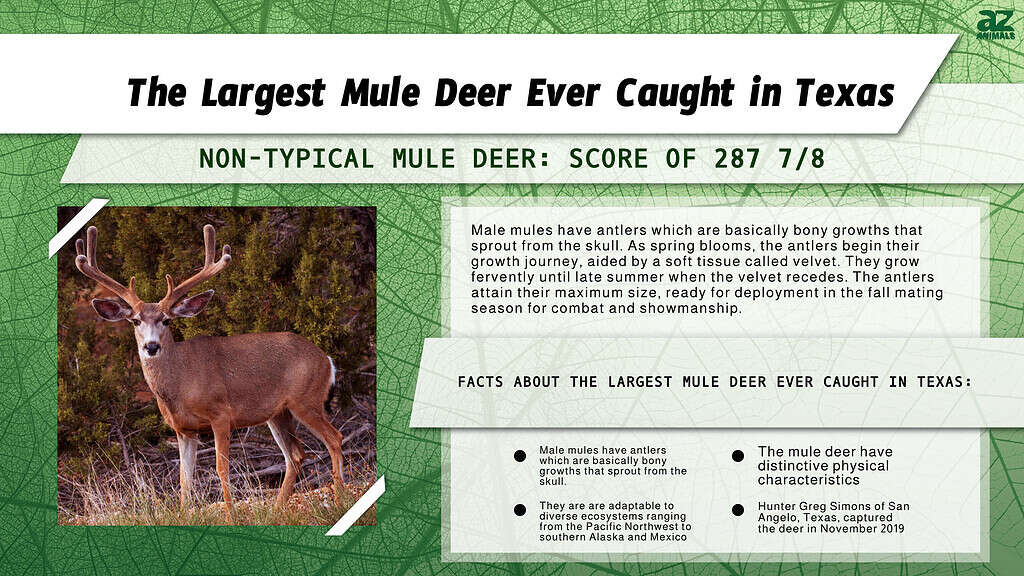
Background Information on Mule Deer
Physical Characteristics
Mule deer have fur that serves dual purposes of hiding and thermoregulation; their coat changes from tawny-brown in hot seasons to grayish-brown in cold seasons. Their conspicuous ears serve as a defense mechanism, allowing them to detect predators and communicate with peers. Their eyes on the lateral aspect of their head expand their visual range.
Additionally, their nose, a highly sensitive organ, facilitates olfactory perception to locate food and potential mates.
Male mules have antlers which are basically bony growths that sprout from the skull. As spring blooms, the antlers begin their growth journey, aided by a soft tissue called velvet. They grow fervently until late summer when the velvet recedes. The antlers attain their maximum size, ready for deployment in the fall mating season for combat and showmanship. As winter approaches and the mating season concludes, the antlers break up.
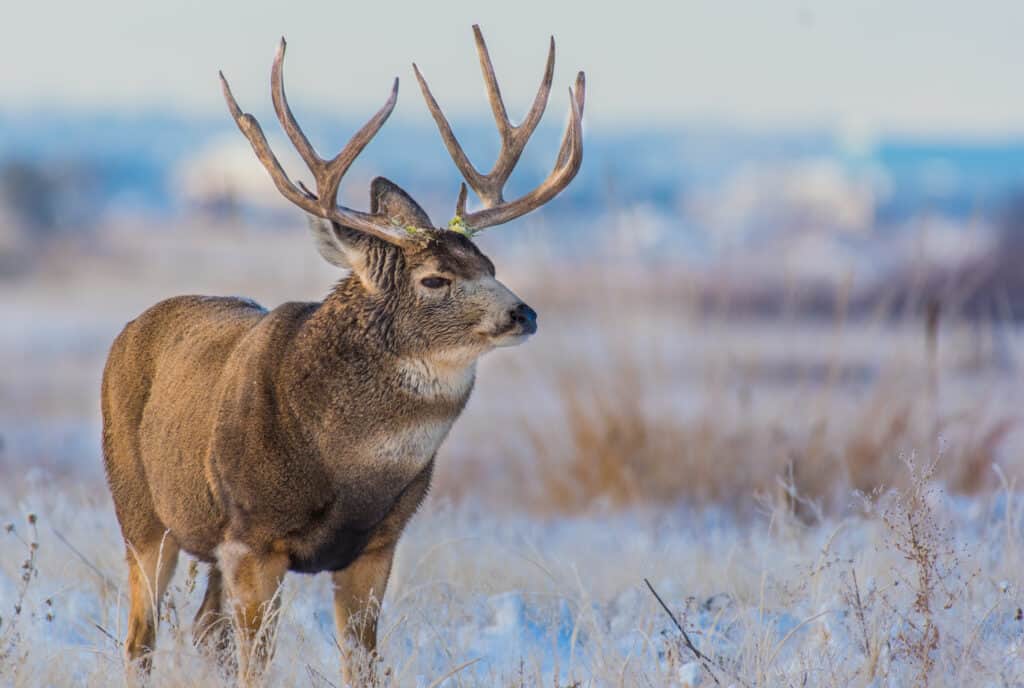
Discover the remarkable physical attributes of the mule deer, distinguished by its iconic large ears and striking dark facial markings.
©iStock.com/Kerry Hargrove
Size and Weight
The weight of a mature male mule deer, on average, tips the scales at a whopping 200 pounds (91 kilograms), while their female counterparts are comparably lighter and weigh 140 pounds (64 kilograms). Both sexes reach a median height of approximately 3 feet (0.9 meters).
The Rocky Mountain mule deer (Odocoileus hemionus) is the biggest of them all, towering up to 4 feet (1.2 meters) at the shoulder and boasting a massive heft of up to 300 pounds (136 kilograms).
Habitat and Distribution
The mule deer, a species predominantly residing in western America, tends to dwell in diverse ecosystems. These habitats include grasslands, desert scrubs, forest edges, boreal forests, and meadows. Moreover, the species can live in agricultural areas and pastures in some regions.
Across much of North America to the Mississippi River’s west, numerous mule deer subspecies inhabit the area. These deer can survive in regions as far north as southern Alaska and as far south as Mexico.
Subspecies of Mule Deer
Mule deer can be divided into two primary groups: the mule deer and the black-tailed deer. The black-tailed deer group involves two subcategories: O. h. columbianus and O. h. sitkensis. On the other hand, the mule deer cluster embodies eight subspecies thriving in varied habitats and territories across western North America.
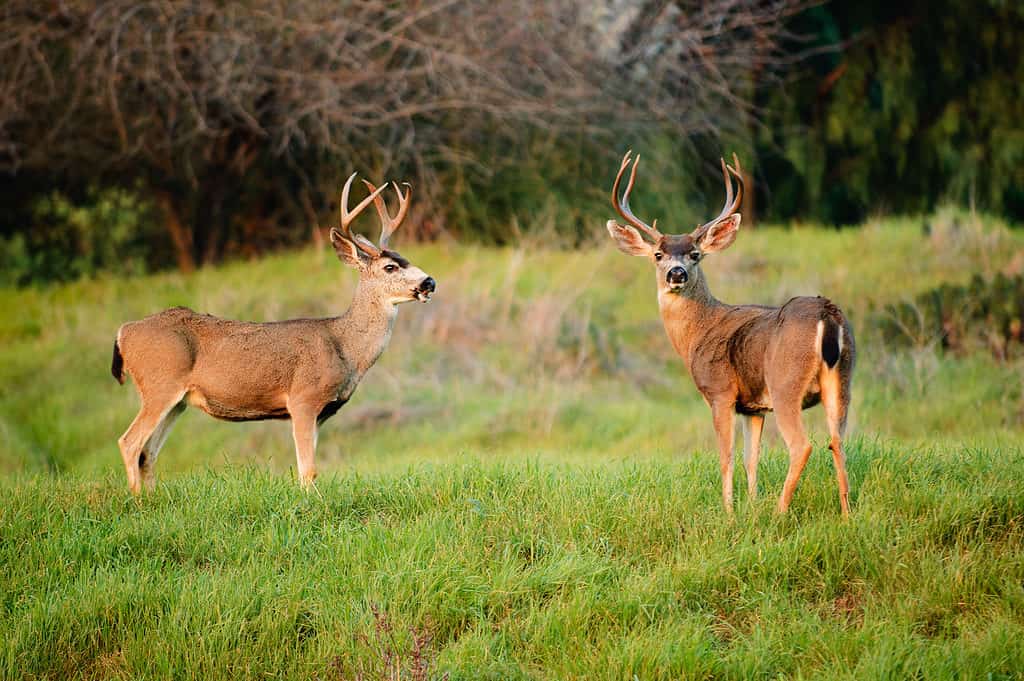
From striking coat patterns to distinct
antler
formations, the black-tailed deer stands out as a testament to the wondrous diversity within the mule deer family.
©Jeffrey B. Banke/Shutterstock.com
Social Behavior of Mule Deer
Mule deer are social animals. They’re known to congregate in clusters of diverse sizes, influenced by various factors such as seasonality and terrain. Their highly evolved communication system involves vocal expressions, bodily stances, scent emissions, and visual cues.
During most of the year, mule deer segregate by sex and age. Adult males (bucks) form bachelor groups of two to five individuals, while adult females (does) and their offspring form maternal groups. Juvenile males leave their maternal groups when they are about one year old and join bachelor groups or become solitary.
Mule deer exhibit migratory behavior, traversing various environments for food and favorable weather conditions. Certain herds undertake epic journeys spanning vast distances, migrating from low-lying winter ranges to high-elevation summer ranges. Additionally, these creatures can adapt to anthropogenic habitats, including cultivated fields, suburban areas, and intertidal regions.
Mating Habits of Mule Deer
The reproductive cycle of mule deer is an annual event. It’s marked by a tumultuous period known as the rut, which runs from the latter part of November until early December. During this season, mule deer undergo a significant shift in their sociability, transforming into aggressive and territorial creatures.
Bucks compete for access to female deer (does) by displaying their antlers, body size, and dominance. They also mark their territories with urine, feces, saliva, and scent from glands on their forehead and legs. Bucks may fight with each other using their antlers.
Mate Selection
In the quest for a mate, does are highly particular and discriminate in their selection of mates, factoring in such variables as antler size and shape, body fitness, and behavioral tendencies of potential suitors. Female mule deer may indulge in the pleasure of the company of numerous bucks. Bucks themselves may also engage in sexual activities with multiple does, provided they can successfully ward off competition from other male suitors.
After mating, bucks and does separate and resume their pre-rut social groups. Mule deer gestate for about seven months and give birth to one or two fawns in late May or early June. Fawns are born with spotted coats that help them camouflage in the vegetation. They stay with their mothers for about a year until the next rut.
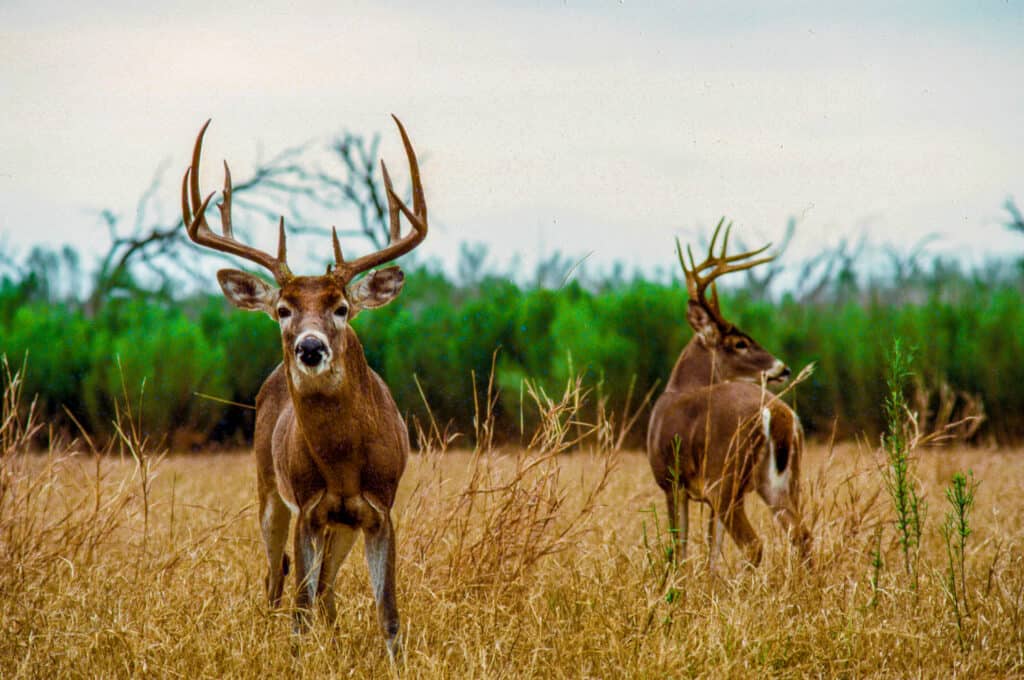
Bucks compete for access to female deer (does) by displaying their antlers, body size, and dominance.
©iStock.com/Dan Richards
The Difference between Mule Deer and White-Tailed Deer
The mule deer and white-tailed deer differ in their antler structure and tail hue. The mule deer’s antlers fork into two branches while the white-tailed deer sprouts from a single beam with tinier tines. As for tails, the mule deer has a small white tail with a black tip, whereas the white-tailed deer is brown with a white underbelly that they show off when startled. Additionally, the mule deer moves in a bounding fashion distinct from the white-tailed deer.
Predators and Defense Mechanisms
Cougars
The Puma concolor, commonly known as cougars, is a dominant threat to mule deer across numerous regions. These feline beasts adopt an ambush tactic that entails stealth and the element of surprise to seize their targets.
Cougars usually choose isolated, diseased, wounded, or juvenile deer as their preferred catch. By administering a sole bite to the neck or throat, cougars can cause fatal damage by either breaking the spinal cord or hindering the animal’s breathing process.
Defense Mechanism
Mule deer have a range of tactics to steer clear of these feline predators. For instance, they congregate in groups, especially during the fawning season. This group’s living behavior heightens their vigilance and repels cougar attacks. Another strategy they use is to migrate to higher-elevation habitats in the summer, where there’s less food but more cover and cooler temperatures. However, this approach is not foolproof, as cougars can pursue deer upslope and capitalize on their limited mobility on steep inclines.
Surprisingly, mule deer have devised another unique method of evading cougars and other predators — stotting, which involves the deer jumping into the air with all four legs rigid and aligned, then touching down with all four hooves in unison.
Stotting may tell the cougar that the deer is fit and healthy and hence not a desirable prey to pursue. It can confuse the cougar by disrupting its visual tracking, enabling the deer to surmount hurdles and sprint faster on uneven terrain.
Black Bears
Black bears are versatile omnivores, partaking in a diverse diet of flora and fauna that fluctuates according to seasonal and situational variances. Though capable of taking down mule deer across all age and health spectrums, they opt for a more effortless meal selection, such as scavenged remains, fish, or berries.
Mule deer have a few tricks to steer clear of black bears. One such method involves avoiding the feeding zones that black bears frequent, such as berry patches, salmon streams, or even rotting carcasses. These animals also have a strong sense of smell and hearing, enabling them to detect bears from a distance. Although they can outpace bears on level or open terrain, the tables may turn when they are on steep or forested ground where bears can leverage their strength and agility to give chase.
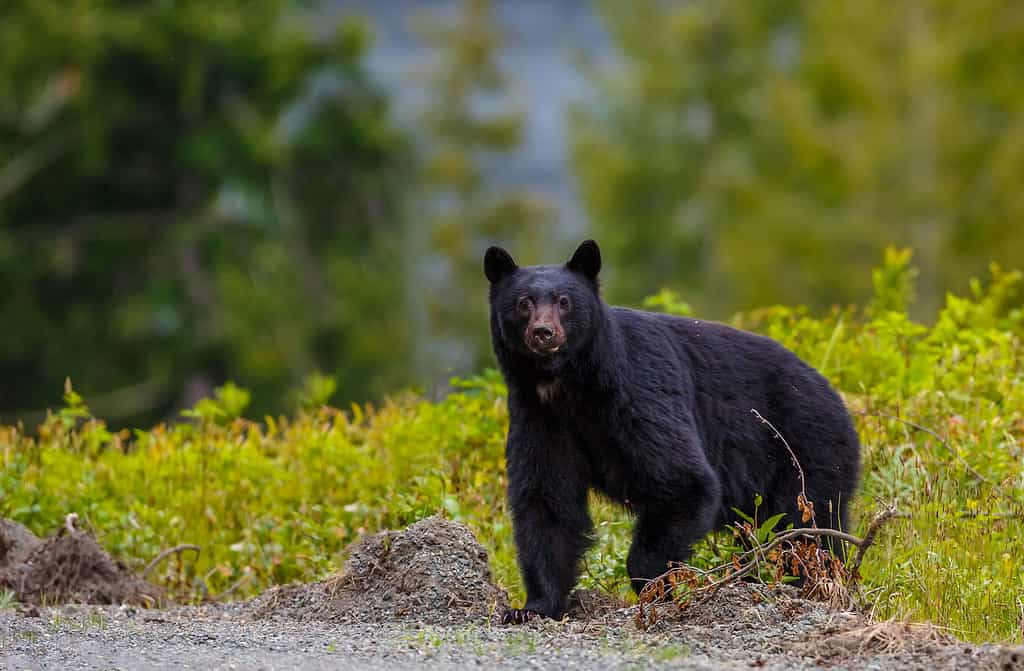
The formidable black bear is an apex predator and a significant part of the natural ecosystem where mule deer reside.
©Menno Schaefer/Shutterstock.com
Coyotes
Coyotes (Canis latrans) have mastered adapting to diverse environments and food options. With their unwavering opportunistic streak, these predators can expertly hunt various creatures, from tiny rodents, birds, and rabbits to relatively larger deer. However, their pack mentality kicks in when targeting the latter, primarily preying on those vulnerable due to age, health, or other factors.
Defense Mechanism
Mule deer can fend off coyotes through their swift, agile, and enduring nature. They additionally employ their hooves to administer a powerful kick or stomp should a coyote become too close for comfort.
Mule deer fawns lack any detectable scent for the initial few weeks of their development; this renders them wholly undetectable to coyotes that rely on olfactory perception to locate their unsuspecting prey. Furthermore, their coat is decorated with speckles that camouflage them to their natural surroundings. As they await their mothers’ return from foraging, the fawns remain inert and soundless, only stirring into action once they hear their mothers’ calls.
Wolves
Wolves (Canis lupus) are apex predators that can take down large prey collaboratively. Once a widespread presence throughout North America, these creatures were nearly wiped out from most of their turf owing to human persecution and loss of habitat. However, they’ve made a comeback by being reintroduced or recolonizing specific regions where mule deer have made their homes, including Utah and Yellowstone National Park.
Employing an assortment of tactics, including but not limited to pursuing, surrounding, irritating, or isolating their target from the group, wolves are masters of hunting.
Mule deer have few options to cope with wolves. They can try to outrun them or fight back with their hooves.
Golden Eagles
Golden eagles can prey on medium-sized mammals like rabbits and geese to reptiles. Nonetheless, these formidable predators occasionally exhibit their audacity by taking on larger animals, such as lambs, deer, and even tender young bears. In a remarkable instance captured by a camera trap in Russia in 2013, a golden eagle exhibited its ferocity by successfully bringing down a deer.
The mule deer can defend itself from these birds of prey by maintaining heightened awareness, concealing itself in thick foliage, or bolting to open spaces where it can outpace the eagles.

Golden eagles occasionally exhibit their audacity by taking on larger animals, such as lambs and deer.
©Martin Mecnarowski/Shutterstock.com
Humans
In mule deer predation, no predator wields more sway or sparks more controversy than humans. Our kind pursues mule deer with a complex blend of motives, including sport, food, and the acquisition of trophies. Yet our impact on this species extends beyond the hunt, as our actions have indirect consequences such as modifying their habitat, introducing diseases, competition for resources, and unfortunate collisions with vehicles.
Mule deer employ the art of camouflage with great finesse. Come autumn and winter, their fur seamlessly merges with the surroundings, rendering them nearly invisible.
Threats to the Species
Mule deer battle against a myriad of hazards that jeopardize their very existence. Among the main threats are habitat loss, disease, predation, and poaching. Human development continues encroaching on their natural range, depleting vital nourishment and water sources and leaving them vulnerable. Disease outbreaks, such as Chronic Wasting Disease (CWD), severely threaten mule deer populations’ health and reproductive potential, compounding their fragile status.
The Largest Mule Deer Ever Caught In Texas
The largest buck that shattered all records in Texas was taken down by the skilled hunter Greg Simons of San Angelo, Texas, in November 2019. Astoundingly, Simons had been on the trail of this creature since it was a mere 3.5 years old, displaying remarkable patience by passing on the buck multiple times. This deer was a non-typical mule deer and had a score of 287 7/8.
Employing unconventional tactics to stalk his prey, Simons spotted the elusive buck from a lofty 12-foot step ladder nestled within the bed of his pickup truck. He finally killed the deer at just 50 yards after a four-year journey.
The previous TBGA state record was set by Damon Compton, who brought down a Reeves County buck with an astronomical score of 283 back in 2003.
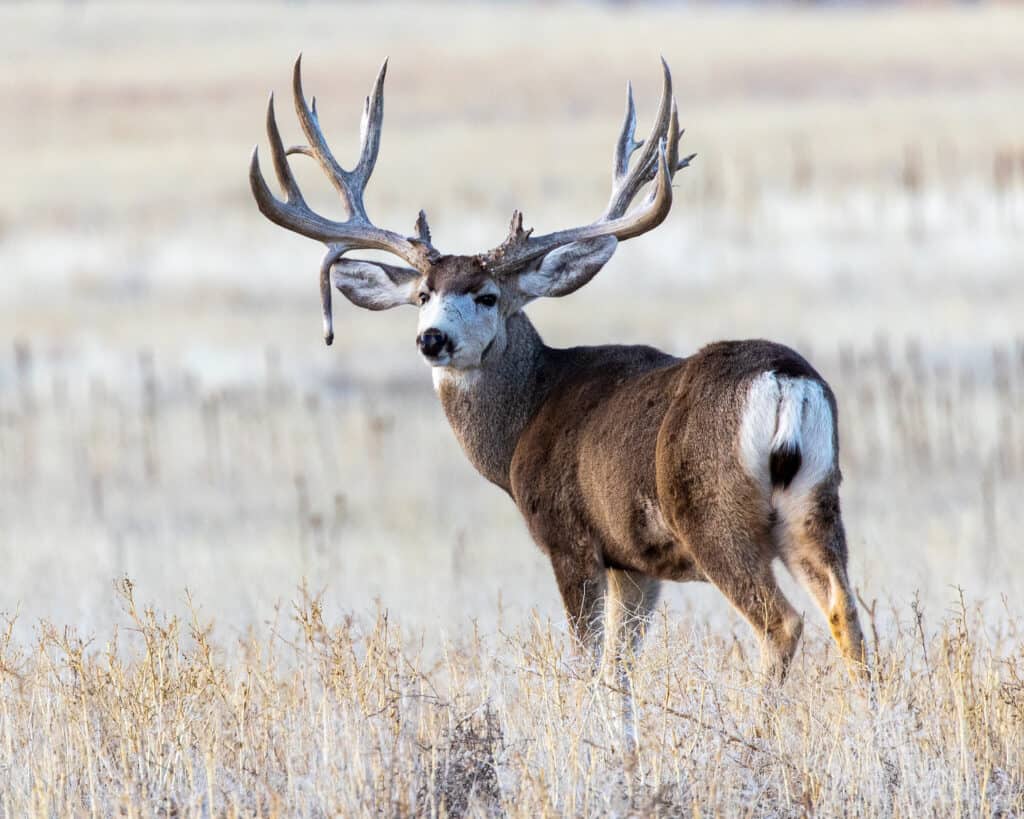
The largest mule deer buck that shattered all records in Texas was taken down by the skilled hunter Greg Simons of San Angelo, Texas, in November 2019.
©iStock.com/Jeff Edwards
The Largest Mule Deer Ever Caught In the World
In a land close to Chip Lake, Alberta, history was made in the fall of 1926. Edmund Broder captured the largest mule deer ever known to man. This colossal creature’s antlers were measured and scored an impressive 355-2/8, a remarkable feat that will forever remain etched in the annals of hunting history.
What Part Of Texas Has The Most Mule Deer?
The Trans-Pecos area, enveloping most of the western section, harbors the largest mule deer in Texas. Allegedly, this vicinity boasts a whopping populace of approximately 150,000 to 250,000 mule deer, contingent on the status of their natural environment.
The Resilience of Mule Deer in a Changing World
The mule deer have distinctive physical characteristics and are adaptable to diverse ecosystems ranging from the Pacific Northwest to southern Alaska and Mexico. Their antlers undergo a cycle of growth and shedding. During the fall mating season, male mule deer employ these antlers for combat and showmanship. Notably, in 2019, a record-breaking mule deer captured in Texas shattered state records. Despite the scary threats of habitat loss and hunting, mule deer thrive and enchant nature enthusiasts worldwide.
The photo featured at the top of this post is © iStock.com/Kerry Hargrove
Thank you for reading! Have some feedback for us? Contact the AZ Animals editorial team.







